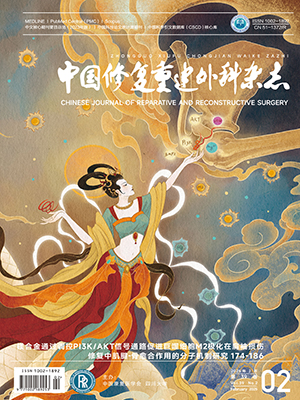Objective To evaluate the biomechanicalproperties and structuralcharacteristics of various composites of partially decalcified allogenic bone matrix gelatin and bone cement at different ratios. Methods According to Urist method, partially decalcified allogenic bone matrix gelatin was prepared and mixedwith bone cement at different ratios of 0, 400, 500, and 600mg/g. Then the comparisons of these composites were performed in microstructure, ultimate compression strength and ultimate bending strength properties. Results The electronic microscope showed that the bone particles and bone cement were distributed evenly in the composite, irregularly connecting by multiple points; with the increase ofbone particles and decrease of bone cement in the composite, there were more and more natural crevices, varying from 100 μm to 400 μm in width, in the biomaterials. Of all the composites with the ratios of 0, 400,500, and 600 mg/g, the measurements of ultimate compression strength were (71.7±2.0) MPa, (46.9±3.3) MPa, (39.8±4.1) MPa, and (32.2±3.4) MPa, respectively; and the measurements ofultimate bending strength were (65.0±3.4) MPa, (38.2±4.0) MPa, (33.1±4.3) MPa and (25.3±4.6) MPa, respectively. Conclusion The compositeof partially decalcified allogenic bone matrix gelatin and bone cement has a good biomechanical property and could be easily fabricated and re-shaped, which make it available to be used clinically as an idea bone graft biomaterial.
Citation: HU Yunsheng,FAN Qingyu,ZHOU Yong,et al.. BIOMECHANICAL STUDY ON THE COMPOSITE OF ALLOGENIC DECALCIFIED BONE MATRIX GELATIN AND BONE CEMENT. Chinese Journal of Reparative and Reconstructive Surgery, 2002, 16(2): 97-99. doi: Copy
Copyright © the editorial department of Chinese Journal of Reparative and Reconstructive Surgery of West China Medical Publisher. All rights reserved




